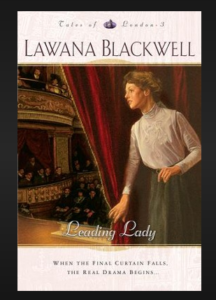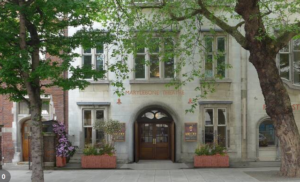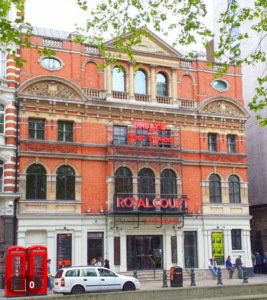Douglas Pearce and his sister Lady Muriel Pearce Holt are the “bad” guys in Lawana Blackwell’s 2004 novel entitled Leading Lady. Douglas’ twin brother, Bernard, is a Vicar in the Church of England, and a redeeming figure in the story. Available in paperback and Ebook, this 432-page romance creation is book 3 in the series Tales of London, which uncovers the complicated characters of theater in the country’s capitol of London in the late 1800’s. As a family historian and former broadcaster I am more into television news and news magazines than romance novels, but my wife Susan likes them, especially ones dealing with her Amish heritage. Our church library is usually her source. After supper and a round of local and national TV news we usually head for bed, books and periodicals in hand. I still remember that night, after we had just settled in and she exclaimed, “You won’t believe this. The main characters in my book are the British Pearces.” What she didn’t tell me was that two of the three prominent namesakes displayed, shall we say, had less than virtuous character traits. We’ll learn about them in a minute.
But first a little history of London, and in particular the theater district where much of the action takes place. I’ll share some memories of a trip Susan and I took there a few years ago and the connection my ancestors had to that part of town. We’ll look at the general story line and a few of the characters in Leading Lady, and oh yes, there’ll be some surprises at the end. Above all, we hope that at least some of the historical asides will interest and inform you.
The first inhabitants of what is now the world’s most populated city it is believed were known as Britons, part of the Celtic race. They lived in thatched huts along the Thames River. In 43 A.D. the Romans invaded the British Isles and established their outpost there, calling it Londinium. Our Pearces, we believe, originally came from across the English Channel, a Norman settlement on the coast of France. They were awarded land after the famous 1066 conquest by William “The Conqueror.” While we’re uncertain of exactly where they settled, our ancestors came to America from Wiltshire County, west of London, and home of the Salisbury Cathedral and Stonehenge. Of particular interest is that those Pearces of 1813, brother and sister, married a sister and brother named Austen from Kent, a county just south of London. A famous uprising there in 1381 is mentioned in the book as “The Peasants’ Revolt” by “Kentish Rebels” (p. 82).
According to our Original Family Narrative (OFN) the Pearces and Austens were married in St. Marylebone Church, famous for the music of its organist and hymn writer, Charles Wesley. Still active, it has been known as “The Queen’s Church” because of its nearness to Westminster and is attended by various royalty, according to the OFN.
As London grew, the small hamlets, such as Kensington, Mayfair, and Chelsea became part of the “Entertainment Center” or “Theater District,” home to dozens of showplaces, including one named Marylebone, known as being “state-of-the-art.” (p.216). But the center of our book’s action is the Royal Court Theater, originally opened in 1888 and now carries the reputation as “The Writers’ Theater.” The main character there is 21-year old Bethia Rayborn, costume designer and student at Girton College, part of Cambridge University to the north. She is promised to a young musician named Guy, who is away in Spain furthering his education. To keep it simple, Bethia inadvertently “bumps into” a very handsome young man named Douglas Pearce, a few years older than she, dark hair, six-feet tall, and actually a distant cousin. They have lunch and she thinks that that is the end of it all. But Douglas is enamored with Bethia, “love at first sight,” you might say. He writes a letter to her at college, send her flowers, and even takes the train up to see her. Because the female students are escorted to campus, he isn’t permitted to drop in on her. Because of her love for Guy and because Douglas seems to be “tracking” her, she is furious. She tears up his letter, gives the flowers away, and writes a rather nasty note back to him asking him to stay away – that she is “not available.”
Amid all the sub-plots, especially since everyone seems to be related to one another, Douglas is heart-broken and takes a boat to the Canadian wilds in hopes of striking it rich in the gold fields. The author informs us, and we’re not sure why, that Douglas is attending a Presbyterian church (p.240) in the New World, especially since his twin brother and the one of the story’s protagonists, Bernhard (p.233), ministers in the Church of England. If you know history, the Presbyterians were the Jacobites of Scotland, enemies of Catholic King Charles in 1661. I have written about our relative, Rev. William Jack, a Presbyterian minister in Dublin, who was removed from his office by the Catholic king. Ironically, it was the the Scottish King James VI who was brought down to London to rule in 1603 and renamed James I. But our Douglas Pearce is killed (p.233) in an accident. When Bethia finds out, she is very sad, thinking that it was her letter of rejection to him that made him go to Canada in the first place. But, when the twins’ sister, the story’s antagonist, Lady Murial Holt (nee Pearce) finds out about the letter and the death of Douglas, she is angry beyond description. This is where the plot takes off.
So, in addition to the wonderful history of England and the rich descriptions of the many places therein, the author spends many words in describing the characters in the novel, especially Murial (p. 370). I won’t spoil the ending here by revealing Murial’s transformation, but let’s just say there is a happy ending.
Another positive about this book is the inclusion of many plots and scenes from other, actual theater productions that have taken place in London over the years. One in particular caught my attention, since my maternal ancestors were Scots-Irish: the story of a fictional Lord John Grey (p.155) of York, part of the Midlands. This part of the Isles tended to go back and forth between rule from Edinburgh and London, depending on which side won the last battle. I have included other writings on Scottish history in E-gen.info’s book section. The novel, Mine is the Night, by Liz Curtis Higgs, is highly recommended. If anyone has been to the British Isles, it will bring back many wonderful memories, as does the Blackwell book on London.
Author Lawana Blackwell lives in Frisco, TX, with her husband. They have three sons. This writer has published 13 books, most of which are set in the British Isles, including the popular Gresham Chronicles series. After reading Leading Lady I wondered how the author chose these Pearce names as main characters, especially the darker ones, Douglas and Murial. In Googling them, I found that the late and dark “Douglas Pearce,” who went by simply “Douglas P.”, was an openly gay, punk British musician whose songs dealt with death, the same name he gave his band. Searching “Murial Pearce” presented a variety of responses, from a French sports writer to a nurse. Likewise “Bernard Pearce” offered up an even wider array of persons, from sports figures to musicians. Blackwell’s choice of character names: coincidence or on purpose? Good question.
Whether you’re male or female, family historian or one who reads for pleasure, we believe you’ll enjoy the works we’ve mentioned above. They and the rest of those titles reviewed on our Family History Book Review page will educate, inform, and inform – on the patio, in the living room, or bed room any time of the year. Your response is always welcome below.
Last revised 9/12/23




